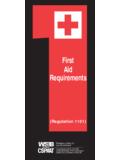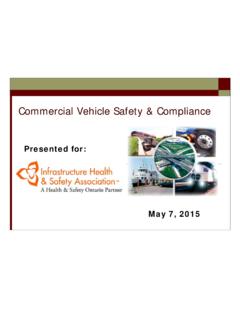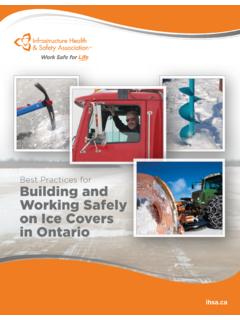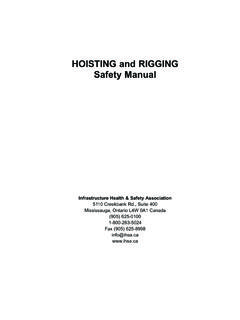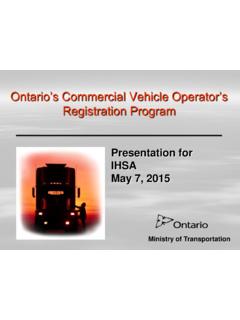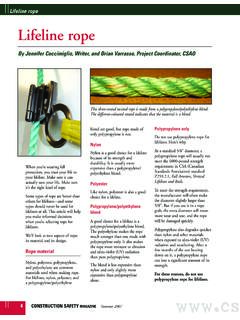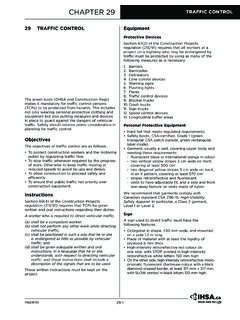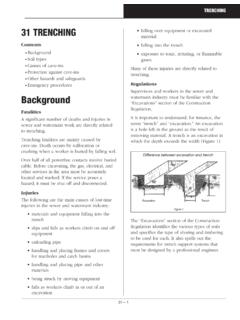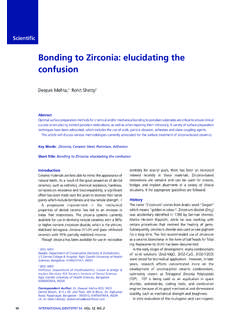Transcription of 1. Introduction 21 SCAFFOLDS - IHSA
1 21 121 SCAFFOLDSC ontents1. Introduction2. Problem areas3. Selection4. Basic types of scaffolds5. Scaffold components6. Erecting and dismantling scaffolds7. Scaffold stability8. Platforms9. Proper use of scaffolds1 INTRODUCTIONMore than half of scaffold accidents in Ontarioconstruction are falls. Several fatalities are also related toscaffolds each year. The number and severity of injuriesinvolved make scaffold accidents one of the more serioussafety problems in PROBLEM AREASThe main problem areas are erecting and dismantling SCAFFOLDS climbing up and down SCAFFOLDS planks sliding off or breaking improper loading or overloading platforms not fully planked or decked platforms without guardrails failure to install all required components such as baseplates, connections, and braces moving rolling SCAFFOLDS in the vicinity of overheadelectrical wires moving rolling SCAFFOLDS with workers on the Erecting and DismantlingFrom 15 to 20% of scaffold-related injuries involveerecting and dismantling.
2 The most common problem isthe failure to provide an adequate working platform for aworker to use when installing the next lift of from one or two planks is not next important consideration involves components,such as tie-ins, which you should install as the assemblyprogresses. Failure to do so makes the scaffold lessstable and, while it may not topple, it may sway or moveenough to knock someone off the platform. This happensmore often when platforms are only one or two plankswide and guardrails are missing, as is frequently the caseduring erection and Climbing Up and DownApproximately 15% of scaffold-related injuries occur whenworkers are climbing up and down. Climbing up and downframes is a common but unacceptable practice that hasresulted in numerous injuries and fatalities. Climbing upand down braces is also a frequent cause of must provide adequate ladders to overcome thisproblem.
3 In addition, workers must use proper climbingtechniques (three-point contact). Planks Sliding Off or BreakingMany scaffold injuries involve problems with planks. Ifscaffold planks are uncleated or otherwise unsecured theyeasily slide off this causes a surprising number ofinjuries. Scaffold planks can also break if they are in poorcondition or overloaded. It is therefore important to useproper grades of lumber and to inspect planks beforeerection to ensure that there are no weak areas,deterioration, or cracks. Another common problem isinsufficient or excessive overhang of planks at theirsupport. Excessive overhang can cause a plank to tip upwhen a worker stands on the overhanging overhang is a leading cause of planks Improper Loading or OverloadingOverloading causes excessive deflection in planks andcan lead to deterioration and breaking. Overloadingoccurs most often in the masonry trade where skids ofmaterial can exceed 1500 kg (3000 lb.)
4 If material is leftoverhanging the scaffold platform it can cause animbalance leading to the scaffold Platforms Not Fully DeckedThis situation is related to injuries not only during erectionand dismantling but in general scaffold use. TheConstruction Regulation (Ontario Regulation 213/91)requires that all scaffold platforms must be at least 450mm (18 inches) wide. All platforms above metres (8 feet) must be fully Platforms without GuardrailsPlatforms without guardrails are a serious safety problemin construction. Guardrails are an important fall prevention measure not only for high platforms but also for low one-third of the falls from SCAFFOLDS are fromplatforms less than 3 metres (10 feet) in height. Therefore,guardrails are recommended during normal use for allscaffold platforms over metres (5 feet) high. Guardrailsfor all working platforms should consist of a top rail, a mid-rail, and a Failure to Install All Required ComponentsFailure to use all of the proper scaffold components is a serious safety problem.
5 Workers are more likely to cut corners when SCAFFOLDS are only a few frames in height. Alltoo frequently they fail to install base plates, braces,proper securing devices such as banana clips or pigtails at the pins of frame SCAFFOLDS , and adequate erecting the scaffold must have all the necessarycomponents, and must use them to ensure that thescaffold is safe. Furthermore, workers should install theseparts as the scaffold erection progresses. Electrical Contact with Overhead WiresScaffolds seldom make contact with overhead electricallines, but when it does happen it almost always results ina fatality. Failure to maintain safe distances from overheadpowerlines while moving SCAFFOLDS is a major attempting to move rolling SCAFFOLDS in outdooropen areas, check the route carefully to ensure that nooverhead wires are in the immediate vicinity. Partialdismantling may be necessary in some situations toensure that the scaffold will make the required safeSCAFFOLDS36383 21_Scaffolds 9-21 3-25_CSAO Responsibilities/Health 10-11-02 2:38 PM Page 121 2clearances from overhead powerlines.
6 The requiredminimum safe distances are listed in Table 1. Hoistingscaffold material by forklift or other mechanical meansrequires careful planning and should be avoided in thevicinity of powerlines. Transporting already-erectedscaffolds by forklift, particularly in residential construction,has been the cause of many electrical contacts this isa dangerous practice. Workers handling materials orequipment while working on the platform must also takecare to avoid electrical 1: Minimum distance from Moving Rolling SCAFFOLDS with Workers on the PlatformMoving rolling SCAFFOLDS with workers on the platform canbe dangerous. Where it is impractical for workers to climbdown, and the scaffold is over 3 metres (10 feet) in height,each worker must be tied off with a full body harness andlanyard. Lifelines must be attached to a suitable anchorpoint other than the scaffold. Holes, depressions, curbs,etc.
7 Have all been responsible for SCAFFOLDS overturningwhile being moved. In some jurisdictions moving a scaffoldwith workers on the platform is prohibited if the platformexceeds a certain height. 3 SELECTIONThe safe and efficient use of scaffolding depends first onchoosing the right system for the job. If the scaffold s basiccharacteristics are unsuited to the task, or if all the necessarycomponents are not available, personnel are forced to makedo and improvise. These conditions lead to selection of scaffolding and related componentsrequires basic knowledge about site conditions and thework to be done. Considerations include weight of workers, tools, materials, and equipment tobe carried by the scaffold site conditions ( , interior, exterior, backfill, concretefloors, type and condition of walls, access for theequipment, variations in elevation, anchorage points) height or heights to which the scaffold may be erected type of work that will be done from the scaffold ( ,masonry work, sandblasting, painting, metal siding,mechanical installation, suspended ceiling installation)
8 Duration of work experience of the supervisor and crew with the types of SCAFFOLDS available requirements for pedestrian traffic through and underthe scaffold anticipated weather conditions ladders or other access to the platform obstructions configuration of the building or structure being worked on special erection or dismantling problems includingproviding practical fall protection for the erector the use of mechanical equipment to aid in erectingthe BASIC TYPES OF Standard Tubular Frame ScaffoldsThis is the most frequently used scaffold in it has been made of steel tubing, butaluminum is gaining popularity. The scaffold ismanufactured in various configurations and spans. Onsome systems, ladder rungs are built into the end frames(Figure ). These ladders are not suitable for tall scaffoldtowers unless rest platforms are installed at regularintervals and trapdoors are provided in the models are equipped with ladders that attach to theend frames (Figure ).
9 The ladder shown in Figure iscontinuous and workers gain access via gates at the platform level. Again this ladder is not suitable for high SCAFFOLDS . SCAFFOLDS in excess of 9 metres (30 feet) shouldhave built-in stairs with rest platforms. Vertical ladders canreach up to 9 metres, but above metres (7 feet) theyrequire a safety advantages of the frame scaffold are that it is simpleto assemble, many construction trades are familiar with itsuse, and the components can be lifted manually byworkers. However, as with other systems, all parts mustbe used. Failure to install any of the components, such asbracing and base plates, may lead to Standard Walk-through Frame ScaffoldsThis is a variation of the standard tubular frame example is shown in Figure Although primarilydesigned to accommodate pedestrian traffic at the groundor street level, the walk-through scaffold is frequently usedby the masonry trade to provide greater height per tierand easier distribution of materials on platforms atintermediate Rating of Power LineMinimum Distance750 to 150,000 volts3 metres (10 feet)150,001 to 250,000 metres (15 feet)over 250,000 volts6 metres (20 feet)Figure FRAME SCAFFOLDL adder rungs builtinto frame not morethan 12 centre tocentreAluminum/plywoodcombination platform36383 21_Scaffolds 9-21 3-25_CSAO Responsibilities/Health 10-11-02 2.
10 38 PM Page 221 Spans of Tower BaseSpan lengths are varied using different lengths of vertical bracing. Most manufacturers have braces providing spansbetween 5 and 10 feet in length, with 7-foot spans beingthe most common. The use of 7-foot spans is ideal whenusing 16-foot planks as this allows a 1-foot overhang ateach end. When using spans in excess of 7 feet, the load-bearing capacity of the platforms is reduced and must beaccounted for in the Rolling ScaffoldsRolling SCAFFOLDS are best suited where short-durationwork must be carried out at multiple locations. They areused mainly by mechanical and electrical trades. Thereare two main types of rolling scaffold. Castor type of scaffold is best suited forwork on smooth floors and is typically used insidebuildings. All castors should be equipped with brakingdevices (Figure ). This kind of scaffold should beerected so that its height-to-width ratio is no greaterthan 3 to 1.
